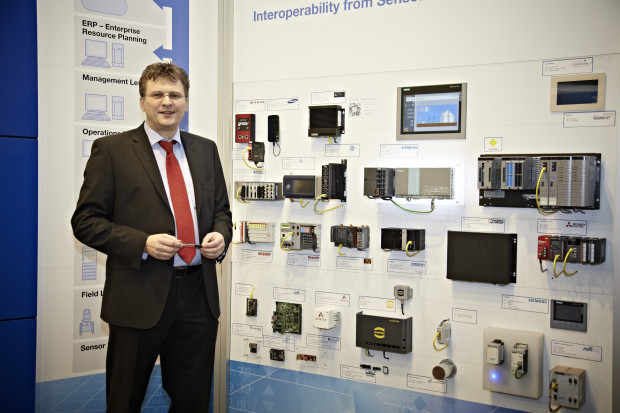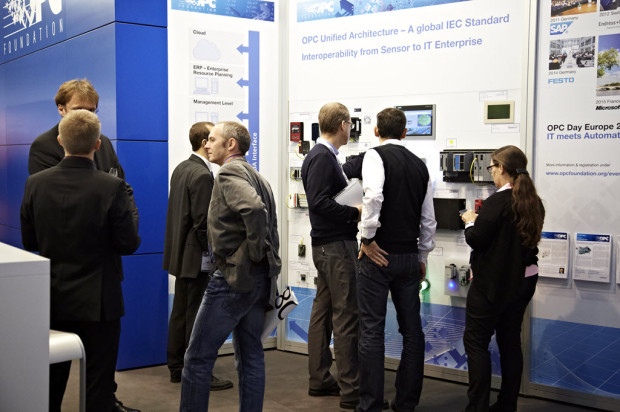
OPC Foundation new Global Vice President Stefan Hoppe at SPS 2014
The IEC62541 standard offers more than just data exchange. The description of the services, modelling of the data of a device and its access permissions are very important in a connected world, since only with this information can machines talk to each other autonomously.
“Security is more than just access permission. Anyone who thinks that VPN connections have anything to do with security should start to learn again very fast,” said Stefan Hoppe, president of OPC Europe. “From the start, OPC UA was built for Security by Design, and so OPC UA offers authentication, signing and encryption.”
The German Bundesamt fuer Sicherheit in der Informationstechnick (Federal Office for Security in Information Technology or BSI) is currently evaluating the security of OPC UA and its results should be available next year. Holger Junker, head of cybersecurity in critical IT systems, applications and architectures for BSI, explained that, “To my knowledge, the only communication technology that has security built in and is ready for the challenges of Industry 4.0 is OPC UA”.
The OPC UA communication infrastructure, for which several standardized information models are being defined, is continuously developing, said Matthias Damm, CEO of Ascolab. “The current data transport is based on client/server architectures. The OPC UA working group is extending the transport layer through a new publication/subscription architecture without any impact on the existing information models. As a result, PLCs or RFID devices can publish their information quickly and directly to many subscribers.”
As a leading representative of the robotics industry, Dominik Boesl, Office of the CTO, KUKA AG and member of the AG2 Industry 4.0 platform, welcomed the extension of a new UDP-based transport to OPC UA. “In addition to the request to publish OPC UA as open source, KUKA also added the requirement to add real-time to the OPC UA standard. This should achieve a complete solution including horizontal communication between robotic controls.”
The modeling capabilities of OPC UA are also used by the AutoID industry, represented by the AIM Organization. Markus Weinlaender, head of product management for industrial identification, Siemens AG and chairman of the group, is convinced of the benefits.
“In view of a common result for a companion standard for Auto-Ident-Systems, the joint working group of OPCF and AIM developed an object model that includes many different identification technologies such as RFID, Barcode, OCR, and Handheld devices,” he said. “At this point, a commented version of the model was created in order to submit it to the member companies for review. The goal is to show not only the first draft of the companion standard at Hannover Messe (Hannover Fair) 2015 but also present the first working prototype.”

OPC booth at SPS 2014
Hoppe, chairman of the common OPC – PLCopen working group, presented the first customer reports from the areas of water management and smart metering for the 22 IEC61131-3 OPC UA client function blocks. These function blocks were finalized in April 2014.
At the request of the OPC Board, Hoppe is now active worldwide for the OPC Foundation as Global Vice President. “Stefan has joined the OPC Foundation as an important catalyst and organizational accelerant for this key role as our technical and marketing evangelist,” said OPC Foundation President and Executive Director Thomas Burke. “He will be assuming many roles as he drives and collaborates with numerous organizations and provides the necessary leadership to enable OPC to be widely accepted and viewed as an integral part of everything related to the Internet of Things and Industry 4.0.”
Burke expressed “the greatest appreciation” to Hans Beckhoff, head of Beckhoff Automation, for agreeing to “fully support Hoppe in his new role and for his continued support and commitment to open standards, and specifically OPC.”
Hoppe said he sees the intensification of activities in the U.S. as his most important task. “I am happy about the additional adoption of OPC by a number of companies. Mitsubishi, National Instruments and IBH Softec now offer their products with an OPC UA interface and C-Labs has the first cloud-relay available. But the real goal should be that OPC UA becomes the worldwide standard for the IoT in the next 3-5 years. The interoperability standard coming from the world of automation,” he predicted, “will influence the IT world.”